- Quick Read
- Deep Read ( 14 Min. )
In Today’s Issue
- CSI Houston: How a Texas lab has remade the science of forensics
- Vaccine passports: Pandemic spurs rise of portable health records
- Domestic abuse surged in pandemic. Britain pushing back with legal reform.
- Super League smashup: US business crashes into English soccer values
- Redemption that goes beyond police reform
- Oscar nominee ‘Quo Vadis, Aida?’ turns lens on legacy of Bosnian genocide
Monitor Daily Podcast
- Follow us:
- Apple Podcasts
- Spotify
- RSS Feed
- Download
TODAY’S INTRO
As seen on TV? The real promise of forensic science.
 Noelle Swan
Noelle Swan
Crime dramas have been around since the early days of television. The genre has since become ubiquitous, with shows about law enforcement making up nearly 20% of all scripted programming in the 2019-20 network television season. That’s not to mention the endless array of cable and streaming offerings.
This steady diet of crime dramas has left many viewers with a distorted view of the justice system. On screen, state-of-the-art crime labs regularly produce definitive forensic evidence in a matter of hours, inflating the public’s expectations. One survey found that nearly half of jurors expect every criminal case to include some kind of scientific evidence. In reality, most police departments do not have access to the kind of forensic analysis seen on TV. Even if they did, forensic science is never going to be as certain as screenwriters make it seem.
The public has discovered these limitations the hard way. Hundreds of convictions have been overturned due to faulty forensic evidence. Some forensic investigators and technicians have exploited public faith in their discipline to pass off shoddy work.
In today’s lead story, the Monitor’s Henry Gass introduces us to a forensic scientist in Houston who is leading the charge to lift his profession up to the standards that the public has come to expect. Peter Stout knows better than most how messy investigations can be. Perfection may never be a reasonable expectation, but he sees forensic science as the best tool for finding “a just result.”
Share this article
Link copied.

Help fund Monitor journalism for $11/ month
Already a subscriber? Login

Monitor journalism changes lives because we open that too-small box that most people think they live in. We believe news can and should expand a sense of identity and possibility beyond narrow conventional expectations.
Our work isn't possible without your support.
A deeper look
CSI Houston: How a Texas lab has remade the science of forensics
Hollywood portrays forensic science as nearly infallible. It isn’t. Now a Houston lab has become a model of reform, boosting trust in this critical part of the justice system.
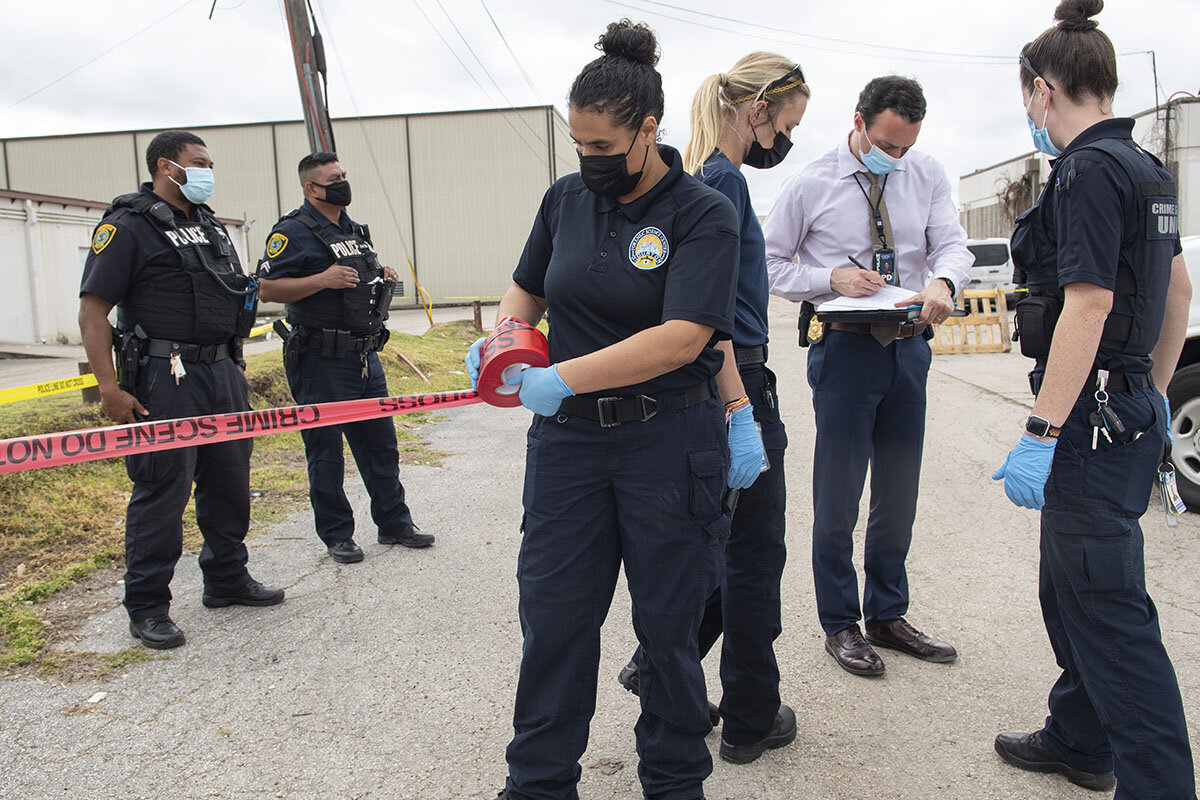
“Concentrate on what cannot lie: the evidence.”
With that simple statement in the pilot episode of “CSI: Crime Scene Investigation,” lead character Gil Grissom voices perhaps the greatest myth about forensic science: its certainty.
Since 1989, bad forensic science has contributed to as many as a quarter of the 2,700-plus exonerations nationwide. Tens of thousands of cases have been found to be tainted by faulty forensic analysis or testimony.
The Houston Police Department had one such lab – consumed by years of mismanagement, neglect, and corruption – out of which grew the Houston Forensic Science Center. It has now become a model of reform. Its leader, Peter Stout – a toxicologist who is an unashamed nerd in a macabre high-tech toy store – sees forensic science as a civilizing force that offers “a just result ... something that actually is fair, evenhanded, and reflects, as close as you can understand, the actual truth.”
“The Houston lab is really doing something special and unique. ... It’s almost a unicorn among crime labs,” says Jessica Gabel Cino, a professor at Georgia State University College of Law.
CSI Houston: How a Texas lab has remade the science of forensics
We don’t know who the woman was, but we know she was sitting in the pickup truck when the burglary went south.
We know it was a September afternoon in 1977, when Cornelia and Ivan Stout returned home to find the truck in their driveway. We know the burglary soon turned into a murder: Ms. Stout was beaten unconscious, and her husband beaten to death with his own .22-caliber rifle – almost certainly by Kenneth Felder, who was shot and killed later that night and had Mr. Stout’s wallet in his pocket.
But here the truth gets murky: Who was the woman in the pickup truck?
Police found a couple of fingerprints on the truck – prints they said belonged to Cherrie Ann Porter. A jury believed them and convicted her of murder.
Ms. Porter may have never been there at all. After four years in prison, her conviction was overturned due to insufficient evidence: A couple of fingerprints were not enough.
To this day it’s unclear if justice in the case has been served or denied. Those decades of uncertainty and trauma might have driven the victim’s grandson to become a cop or a prosecutor. But Peter Stout couldn’t stop thinking about those fingerprints. He became a forensic scientist.
“It weighs on me having had a family that may have been complicit, or participatory, in a wrongful conviction,” says Dr. Stout. “And all that revolved around forensic evidence.”
His life has been defined by a quixotic search to bring scientific truth to the justice system, a search that has led him to the cutting edge of criminal justice reform, heading what some call the nation’s most advanced and innovative crime lab, the Houston Forensic Science Center (HFSC).
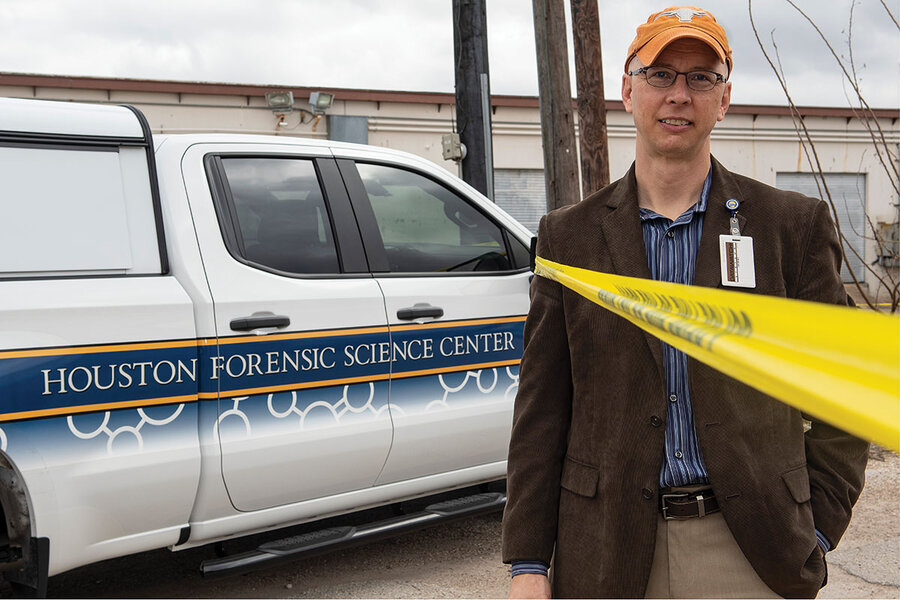
Forensic science is a civilizing force, Dr. Stout believes, because nothing can deliver truth, fairness, and equity to the criminal justice system better than the hard evidence crime labs can unearth and verify.
He sees the criminal justice system as a complex quagmire so rife with human error he isn’t surprised that 9 in 10 Americans want it reformed. In that quagmire, he says, are kernels of hard truth – and in forensic science he sees the best hope of finding them. It can offer “a just result,” he says, “something that actually is fair, evenhanded, and reflects, as close as you can understand, the actual truth.”
Forensic science failed Dr. Stout in his grandfather’s case. It compounded his uncertainty about other brushes with violence he says he experienced early in his life – from an improbable Mafia war in his middle-class Denver neighborhood to his yearslong sexual abuse by a neighbor.
A violent act, Dr. Stout knows better than most, can echo for generations – far beyond just the victim and perpetrator. But while he’s emerged with a successful and comfortable life, he doesn’t want forensic science failing anyone else.
Unashamedly nerdy
In a quiet corner office at HFSC, Dr. Stout does the numbers.
Through the window, downtown Houston sprawls around him, a bottomless pit of casework. The lab produces about 100 reports every day, and each report is about a crime. Each crime touches about 20 people, he estimates, so that’s about 2,000 lives the lab affects each day.
“Across a year, we alter hundreds of thousands of people’s lives,” he says. “The ongoing impact of that – that is the difference of whether civilization becomes more civilized or not.”
Popular culture has long portrayed the world of forensic science as technologically sleek, staffed by bespectacled scientists in lab coats, ingeniously analyzing evidence – and almost never making mistakes.
In reality, despite the existential stakes, many of these laboratories have lacked proper accreditation and oversight; been staffed by overworked, underfunded, and underqualified analysts; and been mired in scandal. And all this has contributed to cases where innocent people were convicted and guilty people walked free.
The Houston Police Department (HPD) had one such lab – consumed by years of mismanagement, neglect, and corruption – out of which grew the reform effort that is HFSC.

The current lab is an unusually well-insulated, well-oiled, and well-funded machine compared with its predecessor. And Dr. Stout is an atypical public face for criminal justice reform: One moment he can reflect somberly, through his own traumas, about the consequences of underinvesting in forensic science; the next, he’s cracking a toothy smile, joking about his baldness, or geeking out like a boy in a macabre, high-tech toy store – unashamedly nerdy.
Indeed, HFSC represents a nerdy brand of criminal justice reform – filled with jargon, acronyms, and huge implications.
Scientific evidence “is disproportionately persuasive evidence, and in that disproportionate power comes an awful lot of responsibility,” says Dr. Stout. “I’m not sure we’ve done a particularly good job historically of treating it appropriately.”
That may now be changing. Turning around one lab doesn’t turn around an entire justice system, he knows, but it’s a good start to a long journey.
The lab now operates independently, outside of – and on an equal footing with – police, prosecutors, and other players in Houston’s justice system. The 208-person staff – three-quarters of which is female, with an average age of 32 – works out of four floors and a few basement rooms in a glass-and-concrete tower shared with the district attorney’s office. Its about $30 million budget funds a “full service” laboratory, with sections for toxicology, DNA, firearms, and latent prints, among other disciplines.
And besides processing evidence for America’s fourth-largest city, HFSC has produced innovations – big and small – that are setting industry standards. It’s working with academics – and publishing research – to improve the validity and reliability of forensic disciplines. It’s a global leader on quality control – the practice of detecting mistakes and ensuring they don’t happen again.
“The Houston lab is really doing something special and unique. ... It’s almost a unicorn among crime labs,” says Jessica Gabel Cino, a professor at Georgia State University College of Law.
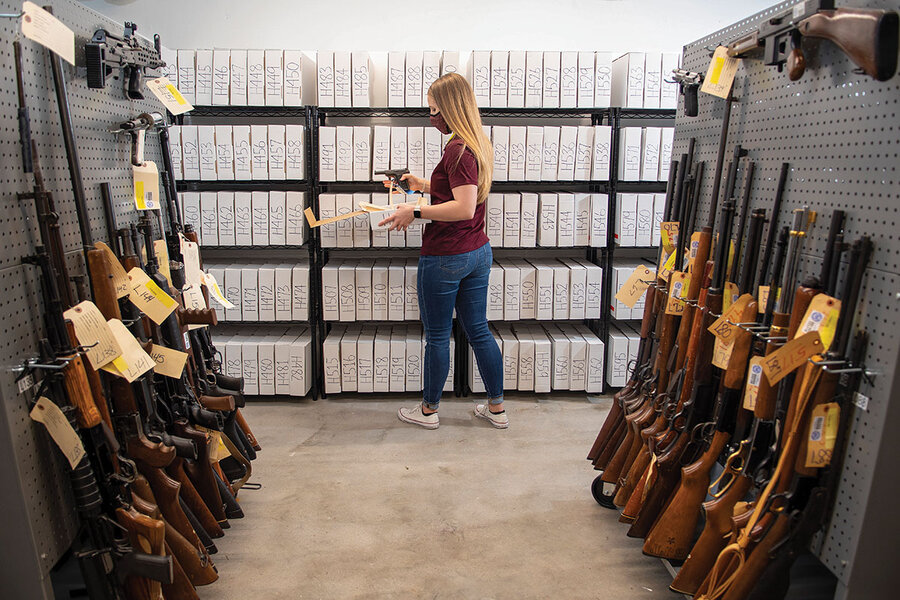
In many respects, HFSC is an outlier among the country’s roughly 400 crime labs. Most remain inside law enforcement agencies, with constrained budgets and staff. Yet they all produce evidence and testimony that are disproportionately persuasive because they come from the presumably precise and hermetically sealed world of forensic science.
The “CSI” problem
“Concentrate on what cannot lie: the evidence.”
With that simple statement in the pilot episode of “CSI: Crime Scene Investigation,” lead character Gil Grissom voices perhaps the greatest myth about forensic science: its certainty.
For decades forensic science has been held up – and has held itself up – as nearly infallible. Did this hair come from that head? Or this bullet from that gun? The crime labs would know.
But did they?
Certainty crumbled in 2009, with the seismic conclusion of a National Academy of Sciences report: When it came to “matching” evidence from a crime to a specific individual or source, no forensic method besides nuclear DNA analysis has “the capacity to consistently, and with a high degree of certainty” make those matching claims.
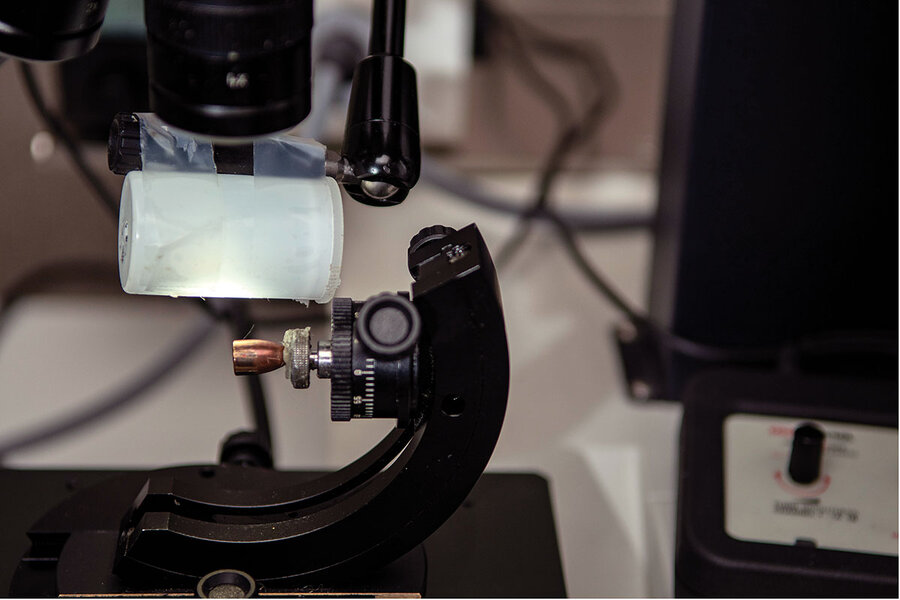
Decades of scientific evidence being overstated or misrepresented – intentionally or otherwise – has had devastating consequences. Since 1989, bad forensic science has contributed to a quarter of 2,700-plus exonerations nationwide, according to the National Registry of Exonerations. Tens of thousands of cases have been found to be tainted by faulty forensic analysis or testimony.
“We’ve made assumptions and given latitude to less-than-rigorous work,” says Dr. Stout. “It’s part of why people don’t trust the justice system.”
The kicker is that no forensic discipline may ever be 100% reliable. But compared with nonscientific forms of evidence – such as eyewitness testimony, which is now widely questioned – forensics “is closer to [being] that kernel of truth,” he says. That uncertainty should in fact be comforting, he adds.
“We are wickedly prone to believing absolute statements,” he continues. “Evidence that should carry much more weight comes with that hard but very necessary conversation about ... its limitations.”
Ultimately, reforming forensic science needs both practical and cultural shifts, from improving standards and procedures to embracing uncertainty and limitations. Analysts being clear about what they know – and don’t know – is especially critical given the weight juries give scientific evidence.
“We have to take the responsibility to produce [forensic evidence] as rigorously as we can,” says Dr. Stout. “Because the number of trials that swing on one piece of physical evidence is really terrifying.”
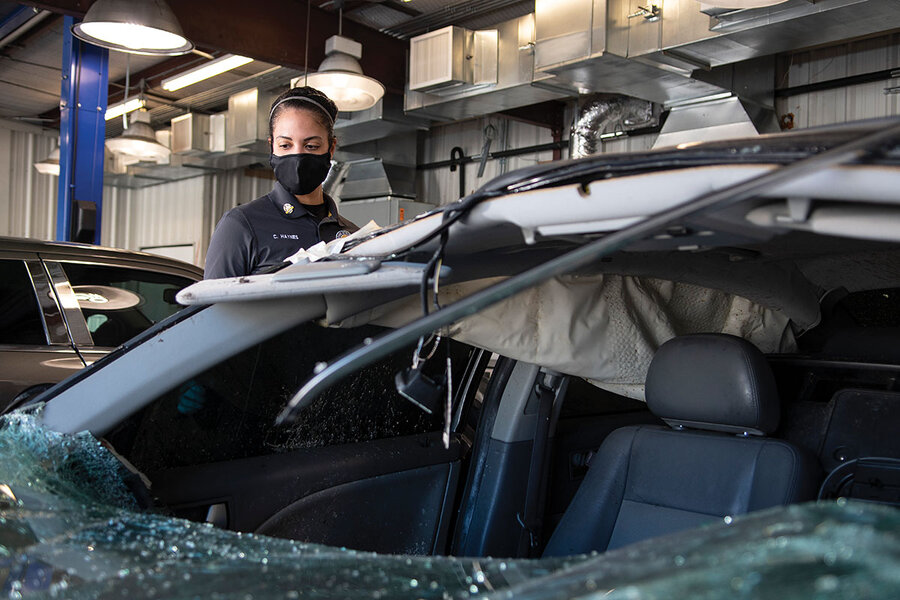
Beyond the yellow tape
The body has been in the dumpster for a few hours at least – maybe a dozen. It’s a male, and he was shot – maybe in the head.
The dumpster sits under a warm, overcast February sky, behind a Brutalist strip mall in an industrial corner of Houston’s west side. The buzz of highway traffic fills the air.
Two Houston police detectives in shirts and ties orbit the dumpster, which is cordoned off by yellow tape. They pause every few moments to study some new detail or jot down notes. A dumpster is a logical place to dispose of a body, but maybe not in front of the store surveillance camera trained on it. After reviewing the footage with a police detective, investigators from HFSC’s crime scene unit (CSU) put up a narrower cordon of red tape.
Of all the reforms HFSC is cultivating, the red tape is a small but significant one. It marks the most sensitive area of a crime scene; you can’t cross it unless you’re in full protective gear. It’s a product of the CSU becoming fully civilianized, not staffed by police officers like it was in the past – and like many CSUs still are.
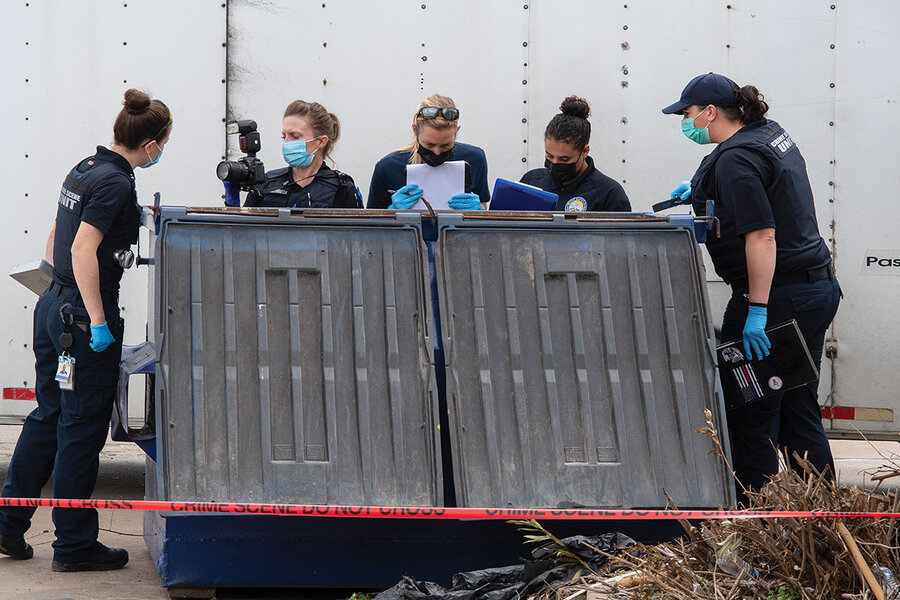
Crime scenes are where investigations start. It’s where the first mistakes can be made, and where the first biases can take root. Having a civilian CSU on scene has let confidence and trust permeate the justice system, says Stacey Mitchell, chair of the HFSC board of directors. In the past “we had officers investigating officer-involved shootings,” she adds. “Because we have civilianized crime scene investigators who are specially trained, [now] everyone is confident that the evidence is the evidence.”
Forensic information travels through a long, meticulous chain of custody, however, and a more secure and expertly managed crime scene doesn’t eliminate the possibility of mistakes down the line.
Which is why HFSC’s most lauded reform has nothing to do with the collection or testing of actual evidence. It’s the testing of the lab itself.
Faking evidence, with purpose
Last year, to verify what the forensic biology division was doing, an HFSC analyst needed some fake evidence. Uncontaminated female DNA, to be precise. So she lifted her hair, swabbed the back of her neck, and sealed it like genuine crime scene evidence in a container to send to the lab.
A well-functioning research facility with well-trained staff would be expected to analyze it and find only female DNA. So when the final analysis revealed a mix of female and male DNA, the analyst had to investigate.
The male DNA ended up being from the husband of the analyst who swabbed her neck – the first of three cases that year of HFSC accidentally contaminating its own “blind test.” Dr. Stout is now considering publishing a paper about it to teach DNA analysts around the country how easy it can be to contaminate samples.
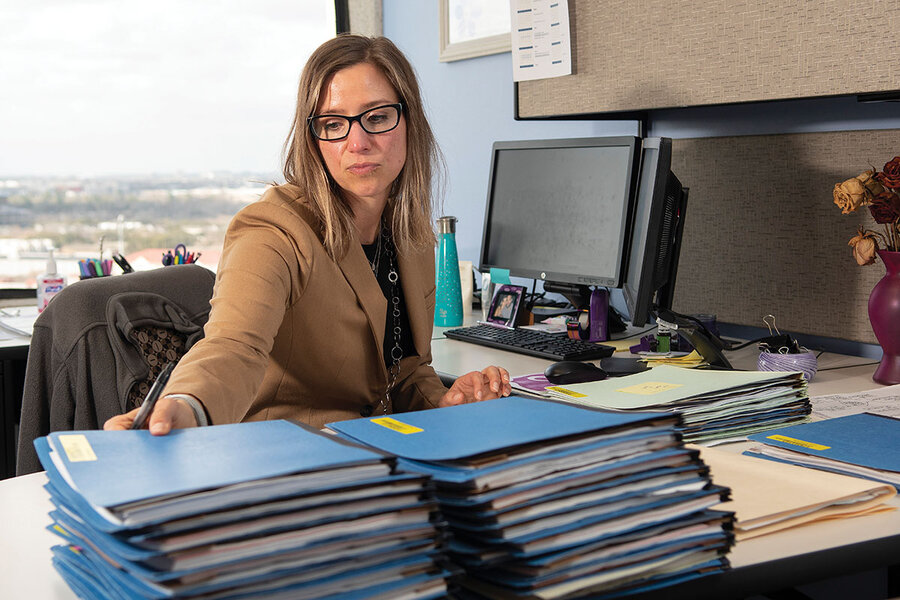
If HFSC has a crown jewel, it’s the seven-person (and all-female) quality division. And if the lab has a standout innovation, it’s the division’s blind testing program. Each year, lab scientists create hundreds of pieces of fake evidence or meticulously fill burner phones with false content like apps, social media posts, and texts to probe for flaws in how the lab is functioning.
“No other lab in the world has done that,” says Brandon Garrett, a Duke University law professor and author of “Autopsy of a Crime Lab: Exposing the Flaws in Forensics.”
Of the 25,000 requests the lab completes each year, about 5% are blind tests. That’s a ratio hand-picked by Dr. Stout – frequent enough that analysts expect them, infrequent enough to be hard to predict. Other labs may do a handful a year, and most don’t do this at all.
The constant surveillance could make for a toxic workplace. But Dr. Stout and the lab’s department heads make it a friendly cat-and-mouse game throughout HFSC. Analysts who identify a blind test win a Starbucks gift card. Those who don’t owe Dr. Stout $1.
More importantly, the lab has normalized a workplace culture that sees mistakes as inevitable and as opportunities to improve, not punish.
“Without that quality check, your answer, even though you have it ... isn’t necessarily the right answer,” says Erika Ziemak, director of the quality division. “Part of what we do every day [is] making sure that we are, as [Dr. Stout] says, the right answer at the right time.”
Independence days
But the foundation of it all is the parity HFSC enjoys in Houston’s justice system. Independence from law enforcement was key to the city’s creation of HFSC in 2014. But in spinning off HPD’s crime lab and CSU to form the center, Houston officials went even further: giving HFSC a corporate, quasi-governmental structure.
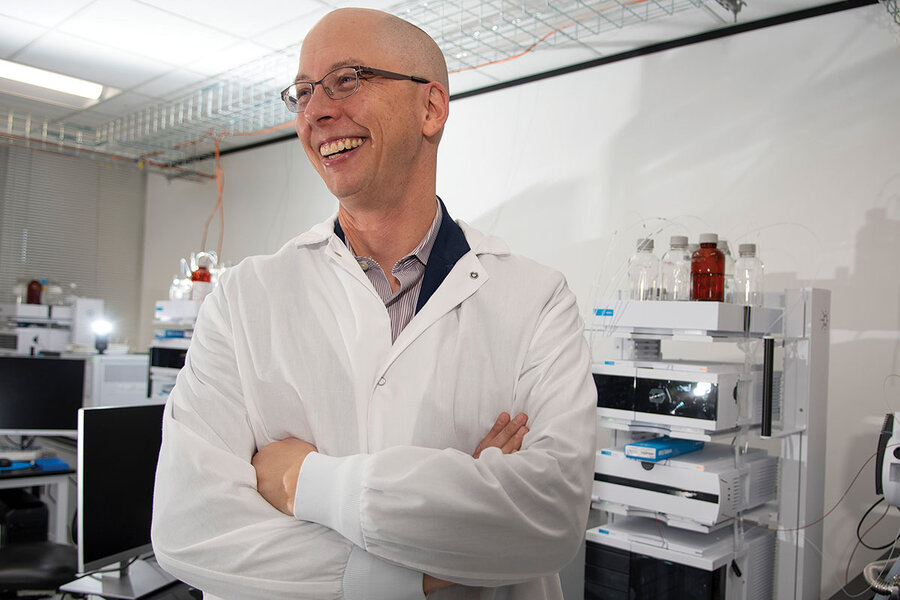
Dr. Stout’s official title is president and chief executive officer, and he reports to a diverse nine-member board of directors of scientists, lawyers, police, and those wrongfully convicted. The board reports to local government the way police and prosecutors do, making their own personnel decisions and budget requests.
The result is not only that a scientist, rather than a law enforcement officer, is in charge, but also that the facility has a bigger budget with a larger, higher-paid, better-equipped staff than most crime labs. And there’s less bureaucracy: Dr. Stout can tinker himself with a new gadget – a drone – to help CSU digitally map crime scenes, which in turn reduces time on-site so they can respond to more than the meager 1% of aggravated assaults they got to last year. And he can provide suitable mental health support for staff members who are exposed daily to the unfiltered horrors of society.
“Tucked away in a police department, [the lab] might not be a very high priority,” says Sandra Thompson, a professor at the University of Houston Law Center who spent seven years on HFSC’s board.
The old HPD crime lab wasn’t just tucked away; it was getting rained on.
“We were stuck in a closet like mushrooms; nobody ever looked at us,” says James Miller, whose 31-year career straddles the old lab and the new, where he heads the seized drugs division.
A leaky roof went unfixed for years, soaking and destroying evidence. The backlog of untested rape kits hit 6,600 at one point, with one victim waiting five years to have hers tested. Senior positions went unfilled, and when misconduct was discovered, punishment was usually lenient. An independent investigation of the HPD lab uncovered four cases between 1998 and 2000 of “dry labbing” (fabrication of or tampering with evidence, a cardinal sin for scientists).
In 2003 The New York Times asked if the HPD crime lab was the worst in the country, or if – more troublingly – it was “typical.” Evidence since then suggests it wasn’t unusual. The biggest scandal of them all is still unfolding in Massachusetts, where tens of thousands of criminal charges have been dropped because of misconduct by two former state chemists eight years ago. St. Paul, Minnesota, closed its crime lab in 2012 after investigations found “major” errors in nearly every aspect of the lab’s work. In 2015 the FBI admitted to presenting flawed testimony on hair fiber comparisons in court for decades.

But as bad as the intentional misconduct is, systemic flaws – underfunding and lack of oversight and standards – are bigger problems, experts say. Reform on that scale takes time, Dr. Stout knows, but he points to the HPD lab. It’s the “archetype of the failed laboratory,” and it was fixed.
“It’s not easy, but you can actually make a difference,” he adds. “You can get to a point where people begin to start trusting what comes out of [labs] again.”
Light in the darkness
Dr. Stout still doesn’t have an elevator pitch for a politician on the importance of forensic science. It’s just too Byzantine.
But if he could take the stairs with a government official, he’d probably talk about his own journey. They would have to walk up the 18 flights to HFSC’s top floor. Slowly.
What happened with his grandfather and Ms. Porter changed his life forever, but he’d already had more exposure to violence than your average preteen. A neighbor was gunned down in a mob hit when he was 3 years old – an age where you might think you imagined something like that. For a long time Dr. Stout did.
That Mafia war in his Denver suburb did happen. But much of his younger years, after his grandfather’s murder, remain wreathed in darkness. His family had all retreated into private shells of grief. No one was really looking out for him, he says, and for several years a neighborhood boy sexually assaulted him.
He doesn’t remember much – in part because he doesn’t want to. But as he’s grown older, as his forensic science career has progressed, he says he’s begun to see through the darkness with a bit more clarity. It’s made him think about trauma, and how it changes memories and lives. It’s made him think differently about those fingerprints on that truck in 1977.
He won’t ever know if Ms. Porter was in that truck. And he may never want to shine a light on every dark trauma in his past. But now he hopes that the forensic science lab he runs can provide a clarity he never enjoyed.
“I keep having to come back to look for those little crystalline facts to try and ground my fractured and fragmented memories,” he says. “I get a lot of assurance out of those facts. And I think what that has led me to is: Others have to have that same thing.”

Vaccine passports: Pandemic spurs rise of portable health records
The pandemic is spurring the rise of portable health records, and businesses could make the so-called vaccine passport a ticket to preferred treatment. It’s an issue with ethical, public health, and economic implications.

- Quick Read
- Deep Read ( 7 Min. )
As Boston-area schoolteacher Laurie Riley heads on a trip to Aruba, she carries something special in her pocket: proof of her COVID-19 test results. An app on her phone, called CommonPass, can store and share health data to help speed her through airport immigration lanes.
So far governments aren’t mandating vaccination for the coronavirus, and corporations are treading cautiously around the idea of “vaccine passports.” But versions of the idea are emerging in some industries like airlines, live entertainment, and professional sports. The same technology that promises to boost convenience, save money, and address public health concerns is raising questions about privacy, vulnerability to hackers, and equity of access, privacy advocates say.
As cruise lines work to convince the federal Centers for Disease Control and Prevention to lift rules that have made it all but impossible to sail from the United States, several of them have proposed requiring proof of COVID-19 vaccination for all adult passengers and crew. But Florida’s Republican governor, Ron DeSantis, has ordered a ban on vaccine passports, citing privacy concerns.
“It does seem a little bit 1984,” says Ms. Riley. But she says she doesn’t mind the technology “if it keeps everyone safer.”
Vaccine passports: Pandemic spurs rise of portable health records

On a snowy April morning, Laurie Riley is heading to Aruba. Prior to the pandemic, she would come to Boston’s Logan Airport with her ticket and passport. Now, she also carries her COVID-19 test results before boarding the flight. She printed them out and also put them on an app in her cellphone, called CommonPass.
In Aruba, the pass will give her access to dedicated immigration lanes designed to speed her through.
“It does seem a little bit 1984,” says Ms. Riley of the app. “But everything now seems like 1984. My fingerprints are out there. My ID.” Ms. Riley, a middle school teacher in Cambridge, Massachusetts, says she doesn’t mind the technology “if it keeps everyone safer.”
The coronavirus has quickly advanced on an international scale something many U.S. health professionals have dreamed about even as privacy advocates have fretted: portable health records. Digitized and accessible to any health provider a customer chooses, they could be carried on cellphones or as a certificate with an embedded chip much as people carry a driver’s license today.
But the same technology that promises to boost convenience, save money, and possibly cut down on medical mistakes also raises questions about privacy, vulnerability to hackers, and equity of access, privacy advocates say. These issues are moving front and center for businesses like airlines that are hoping for a broad economic reopening.
Corporations are acting cautiously. It’s not easy to know what’s best for business – and also for their image as responsible citizens – at a time when vaccines are increasingly available but not mandated by governments. Some firms are demanding that customers or employees show proof of vaccination or a negative COVID-19 test. At present, these are rare instances, concentrated in industries like travel, tourism, and public events.
“Companies are not going to eliminate even a modest percentage of their clientele by putting in place mandatory vaccination policies for services or travel unless the vast majority of their customer base demands it,” writes Summer Johnson McGee, dean of the University of New Haven’s School of Health Sciences, in an email.
And public views vary widely. For example, almost exactly half (49%) of working Americans say employers should require vaccination proof for those employees returning to the workplace, according to a new national poll, conducted by Ipsos for Eagle Hill Consulting. Similarly, a Consumer Reports poll found 42% of Americans say theme park visitors should face a vaccination requirement, but 33% disagree.
Florida’s theme parks and cruise ships
Center stage in the debate is Florida.
Disney World has stayed open for all (face mask required).
But, as cruise lines work to convince the federal Centers for Disease Control and Prevention to lift regulations that have made it all but impossible to sail from the United States, several of them have proposed requiring proof of COVID-19 vaccination for all adult passengers and crew. Royal Caribbean International has ordered it. Norwegian Cruise Line has proposed it to the CDC as part of a plan to start sailing early in July. Other lines are also suggesting it.
Cruises are a key part of Florida’s important tourist economy. But the state’s Republican governor, Ron DeSantis, has ordered a ban on so-called vaccine passports, citing privacy concerns.

“It’s completely unacceptable for either the government or the private sector to impose upon you the requirement that you show proof of vaccine to just simply participate in normal society,” he said. “You’re going to do this and what, give all this information to some big corporation? You want the fox to guard the hen house?”
U.S. law gives companies wide latitude to set the rules of access for their customers and employees. But states have the authority to regulate them, including limiting them from requiring vaccines, Dorit Reiss, a professor of law at the University of California Hastings College of Law in San Francisco, writes in an email. “It would be an unusual use of state authority – usually states act to increase workplace safety, not decrease it – but it’s constitutional.”
Texas has ordered a similar ban, and several other states have voiced opposition to the idea.
“The global need for this”
These states are pushing against a rising tide of corporate, government, and nonprofit activity, however, spurred by the pandemic.
“What COVID has done is really accelerated the global need for this,” says Paul Meyer, CEO of The Commons Project Foundation. The nonprofit began work nearly a year before the coronavirus hit with a plan to create open standards and advocate for portable health records in the United States. Now, it is one of more than a dozen initiatives around the world to digitize, standardize, and quickly verify COVID-19 test results.
So many governments and companies – from amusement parks to cruise ship operators – are clamoring for such a digital infrastructure that it’s quite possible digital health certificates (advocates avoid the term “passports”) will become a fixture even beyond the pandemic.
The industry where it’s coming together first is international air travel.
“The standards are pretty close and a couple months maybe from being finalized,” says Shavon Pinkerton, senior vice president of legislative and regulatory policy at Airlines for America, an industry group. “I don’t know if you use Apple Pay or not, but the concept is very similar... . You have a digital health wallet on your phone.” The measure would be completely voluntary, she hastens to add.
The app is so far limited to providing airlines with coronavirus test results, not vaccine status. And it is designed to speed passengers through what is now a cumbersome, paper-based process. London’s Heathrow Airport, for example, has been slammed with arriving passengers often waiting up to six hours to get through passport control even though the airport is handling only one-tenth of its normal passenger load.
The paper records are not standardized, often come in foreign languages, and can be forged. Officials at Heathrow as well as airports in Canada, France, and Mexico have found fake vaccine test certificates. Fraudulent tests are for sale on the dark web.
That’s why the International Air Transport Association, eight airlines including JetBlue, and other companies such as IBM and Mastercard have joined with the Commons Project Foundation and the World Economic Forum to create the CommonTrust Network and infrastructure around it, including the CommonPass. So far, 32 nations have signed up to use the system.
Inevitably, the system will begin to incorporate vaccine status as well. In early April, Iceland began requiring tourists arriving from outside continental Europe to show proof they had been inoculated with an approved COVID-19 vaccine. On Monday, United Airlines announced it would start daily service in July to Iceland for U.S. passengers who could show they had been vaccinated. Delta will begin Boston-Reykjavík flights for vaccinated Americans on May 20.
Sports venues are also beginning to implement certain restrictions based on one’s health status. The Miami Heat, for example, had offered preferred seating in its home arena to customers who have been vaccinated against the virus. But it discontinued the practice after the governor’s ban. In New York, the Buffalo Bills football and Buffalo Sabres hockey teams have announced that all fans attending home games will have to be vaccinated to be let in.
They will encourage use of New York’s Excelsior Pass, created with the help of IBM, that arenas, stadiums, and concert halls can use to quickly determine test results or vaccine status. By May 1, Hawaii also hopes to roll out a pilot vaccine passport for inter-island travel.
A number of U.S. colleges and universities have also mandated that students and employees this coming fall will have to be vaccinated. (In some instances, state or federal law may make exemptions available for religious or medical reasons.)
Questions of equitable treatment
Such moves raise a number of ethical issues about equity and access. For example, providing a perk such as better seats for vaccinated customers shouldn’t get a sports team in any ethical trouble. Still, companies have to be careful, bioethicists say.
“Modest incentives can be acceptable,” says Ms. McGee of the University of New Haven. “But discriminating on the basis of immunity status should always be avoided.”
Neither the World Health Organization nor the Biden administration backs the idea of government-mandated vaccination passports. “There will be no centralized, universal federal vaccinations database and no federal mandate requiring everyone to obtain a single vaccination credential,” White House press secretary Jen Psaki said late last month. Instead, the administration is creating guidelines to make sure that private-sector initiatives offer equal access to the technology.
For example: People without cellphones shouldn’t be discriminated against, bioethicists say. For customers whom it vaccinates, Walmart is offering to upload digital confirmation of that vaccination to the CommonPass or the CLEAR Health Pass, a separate initiative. If customers prefer, they can have Walmart print out a paper form.
Back at Logan Airport, the future of digital health certificates is in some doubt because even the current technology isn’t working as expected. Kim Carroll, a Boston-area financial adviser, tried to download the Common Pass for her family, but she could only download it for herself. So she printed out the information instead.
Does she worry about a Brave New World of limited access based on health records? “You do what you have got to do,” she says. After all, it’s been snowing in Boston. And Aruba awaits.

Domestic abuse surged in pandemic. Britain pushing back with legal reform.
The U.K. is putting together a once-in-a-generation bill that will redefine what domestic abuse is. In doing so, it could provide a lasting foundation for survivors to restart a life of agency, free from violence.

- Quick Read
- Deep Read ( 6 Min. )
-
By Shafi Musaddique Correspondent
Domestic violence and abuse had generally been in decline in Britain prior to the pandemic, but calls to domestic abuse hotlines have soared since lockdowns began.
Now, Parliament is pushing through a landmark bill that will introduce a first-ever statutory definition of domestic abuse in Britain and offer new support and protections for its victims. Its definition will include not only physical harm, but also emotional abuse, coercive behavior, and even financial abuse. It will also recognize technological abuse, such as spying on a partner, online harassment, and taking control of personal devices.
In addition, the law will place a duty on local authorities to provide survivors and their children with accommodation and specialized support in refuges and temporary housing. Victims will also be granted special measures like appearing in court via video link, and protection from being cross-examined by their abusers in family courts.
But the reforms, which are expected to be passed by late spring, still come within a larger context of misogynistic crime and violence against women, like the killing of Sarah Everard in March, that will require broader societal change and education.
Domestic abuse surged in pandemic. Britain pushing back with legal reform.

Maria Castillo still recalls the stigma attached to the concept of “domestic abuse” in early 2000, when she fled her partner with their then-3-year-old son.
He had knocked on the front door “looking for an excuse to come in,” before violently attacking her for hours in front of his friends. She recalls her face had swelled to the point of numbness. “I didn’t even look in the mirror. ... I just grabbed whatever I needed to grab and left.”
But finding safety and sympathy wasn’t easy. When she sought help at a local police station, she says, an officer referred to her case as “just a domestic.” “The word ‘domestic’ was used as an insult,” she recalls. “It was all still very hush-hush. Domestic violence wasn’t talked about at all.”
While societal attitudes have changed over the past two decades to allow for more open discussions about violence from intimate partners, the law largely has not – until now.
Parliament is pushing through a landmark bill that will introduce a first-ever statutory definition of domestic abuse in Britain and offer new support and protections for its victims. The reform comes as domestic abuse calls have spiked during the pandemic, with lockdowns trapping people with their abusers in the same households for extended durations.
But the reforms, which are expected to be passed by late spring, still come within a larger context of misogynistic crime and violence against women, like the killing of Sarah Everard in March, that will require broader societal change and education.
The pandemic and domestic abuse
Domestic violence and abuse had generally been in decline in Britain prior to the pandemic; between 2005 and 2019, domestic abuse fell year-on-year. But distressed calls to domestic abuse hotlines have soared more than 60% compared with the start of 2020. More than triple the number of people died at the hands of partners in late March in the United Kingdom’s first lockdown, compared with the same period in 2019. And in the period from March to June 2020, there was a 7% rise in domestic abuse offenses recorded by police.
Complicating the problem is the patchwork network of resources, both official and nongovernmental, available to aid survivors of domestic abuse: what many in the sector describe as a “postcode lottery.” Domestic abuse services vary in both quantity and quality between regions and localities, a problem exacerbated by bigger, corporate charities swallowing up vital government funding at the expense of smaller, community-based services left to fend for themselves.
Kayliegh Richardson, a family lawyer and senior lecturer at Northumbria University in Newcastle, England, says “a lack of consistency across the country” has hamstrung help for survivors in the U.K.
“You end up in a judicial and support service lottery where depending on where you live there will be more services available, but also the approach from judges to two [similar] cases will be completely different. And that’s definitely continued in lockdown.”
Ms. Richardson says that courts have been reluctant to grant temporary occupation orders, whereby an abuser is barred from a property shared with the victim, during the pandemic, “because [judges] say the perpetrator doesn’t have anywhere to go or they might be working from home. And so if they’re excluded from the property, it will have an impact on their business and their livelihood.”
The pandemic has allowed some opportunities for progress. Courts have permitted survivors to obtain non-molestation orders – the equivalent of a restraining order in the U.S. – without physically appearing in court, thus avoiding face-to-face meetings with abusers.
But the pandemic, by and large, has caused havoc. Research submitted to British lawmakers by Ms. Richardson shows that over 80% of organizations have postponed or withdrawn some of their services, including face-to-face appointments and group counseling sessions, because of lockdowns and social distancing measures. Fundraising and educational activities have also been delayed, and therapeutic work for adults and children has been canceled since March 2020. And almost a quarter of refuge accommodations have been forced to deny entry to many fleeing home in the past year.
The new law, once it is passed, will solve some of these problems. Its definition of domestic abuse will include not only physical harm, but also emotional abuse, coercive behavior, and even financial abuse. It will also recognize technological abuse, such as spying on a partner, online harassment, and taking control of personal devices.
In addition, the law will place a duty on local authorities to provide survivors and their children with accommodation and specialized support in refuges and temporary housing. Survivors will also be granted special measures like appearing in court via video link, and protection from being cross-examined by their abusers in family courts.
Still, holes will remain, experts say. Migrant women in abusive relationships have no access to public funds for legal representation and no standardized, secure avenue to report abusers without the risk of deportation. And while the bill requires local authorities to provide accommodation-based services for those fleeing abusive relationships, not a single refuge is currently available to men in London – despite 1 in 3 people experiencing domestic abuse in the capital city being male.
Sarah Everard and misogynistic crime
The new efforts to address domestic abuse have taken place amid renewed fierce debate on gender-based violence and misogyny, particularly since the abduction and killing of Sarah Everard by a London police officer. The 33-year-old disappeared on her walk home in early March. As police intensified their search for Ms. Everard, local women were warned by London’s Metropolitan Police about venturing outdoors alone. With walking being one of the few activities allowed during Britain’s lockdown, the suggestion sparked anger.
As women shared stories on social media of walking home at night, the British government amended the domestic abuse bill so that police would be able to record misogyny as a hate crime in England and Wales beginning in the fall. Public discourse also turned to education. Kit Malthouse, the policing minister, suggested boys should be taught at school how to respect women and girls.
Maria Brennan, a program manager for female empowerment organization Rising Girl, says that while teaching gender equality in mixed schools is important, girls benefit from specific education to recognize early signs of abuse toward themselves or their peers.
“We already know there aren’t many spaces for girls to have these conversations from a young age,” she says. “I know I didn’t have this program in my school and it was a really important reason as to why I applied for this job and why I do it.”
While they still bear the scars of their past, women like Ms. Castillo have carved a new life for themselves. More than 20 years since fleeing to temporary accommodation, Ms. Castillo now runs her own business at the heart of London’s famous Camden Market. “A lot of women that come out of refuges end up going back to their abuser because it’s too hard out there. They don’t know what to do,” she says.
Lois Perry endured all forms of abuse in a two-year relationship from a partner who, she says, carried out an “annihilation” of her “entire personality,” taking control of her phone and social media accounts, and destroying relationships between her and family members. But after leaving her relationship, Ms. Perry reunited with her family and has forged a career in broadcasting and activism. She says she has found faith and stability that sustains her rehabilitation.
“Have you ever seen Indiana Jones when he goes into a trance when they burn him and he comes out alive? It’s like that. ... It’s like I’ve been burnt and come out.”

Super League smashup: US business crashes into English soccer values
European soccer’s values of community and custodianship were behind the three-day rise and fall of the proposed Super League, which would have imposed a U.S. corporate sports model on the continent.
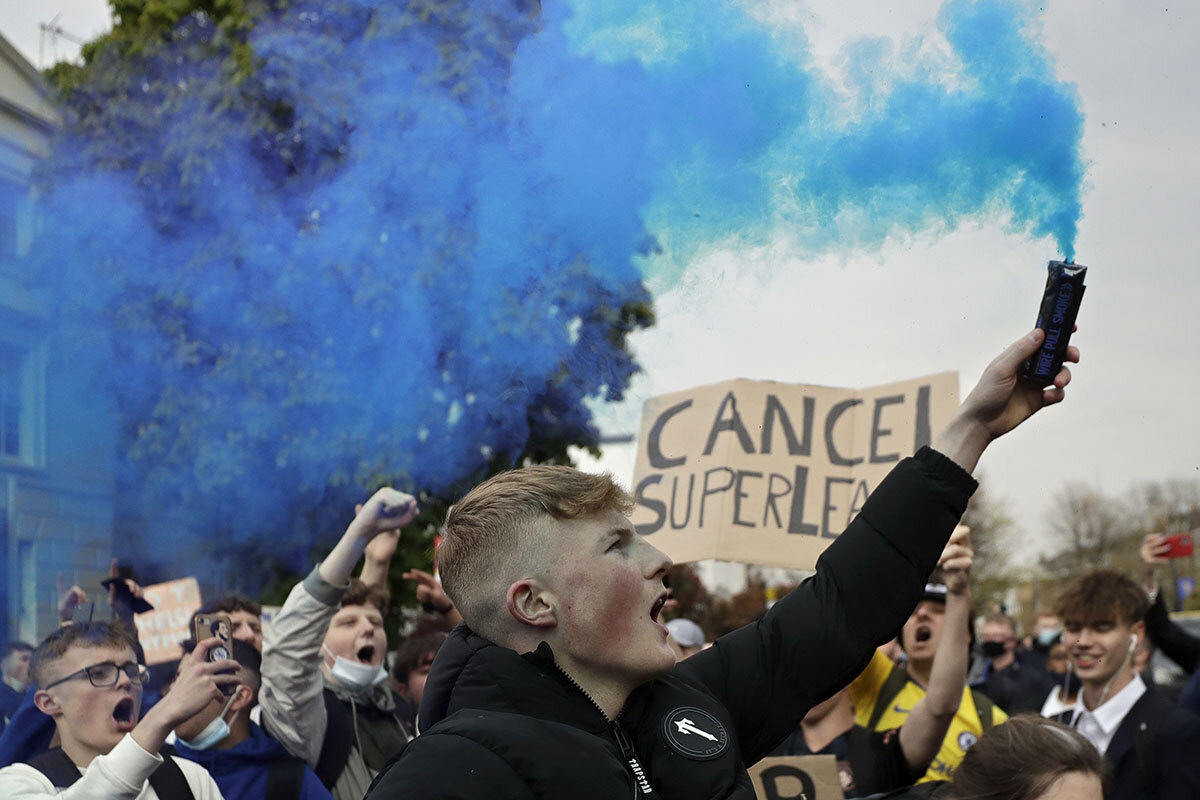
- Quick Read
- Deep Read ( 6 Min. )
-
By Shafi Musaddique Correspondent
-
Noah Robertson Staff writer
It only took 72 hours of outrage and protests to bring the proposed soccer Super League to its knees. The plan to unite 12 of the world’s most storied teams in a closed league fell apart amid backlash from fans, particularly in England where six of the teams reside.
At the heart of the furor was a clash of values, say observers: the cherished models of meritocracy, custodianship, and European fan culture colliding with the U.S. corporate sports model. The Super League project attempted to impose a U.S. approach on the world’s elite soccer clubs, without taking into account the history and values that those clubs were built upon.
In English soccer, every club can climb from the lowest amateur tier of soccer’s pyramid to the top flight – or fall through the trapdoor back down. The Super League would have created a competition separate from the existing pyramid, closely modeling North American sports leagues such as the NBA and the NFL. Stefan Szymanski, professor of sport management, says the decision to scrap a merit-based model ultimately struck at the core of European soccer.
“The fundamental of European soccer,” Dr. Szymanski says, lies in its community-based business approach.
Super League smashup: US business crashes into English soccer values
When, in the late hours of Sunday evening, 12 of European soccer’s powerhouses announced the creation of a brand new European Super League, few could have foreseen the rapid collapse that would soon follow.
The plan was meant to award the founding clubs a share of upwards of £4.8 billion ($6.6 billion) a season from global broadcasting and sponsorship rights for a closed league in the American tradition, like the NFL. Instead, it earned fierce popular and political backlash.
British newspapers described the scheme as an all-out “war” by foreign owners on the beautiful game. British Prime Minister Boris Johnson dubbed the move a “cartel” in need of a “legislative bomb.” Within 72 hours, mass protests across the United Kingdom had tilted owners’ heads enough that they scrapped the Super League at breakneck speed.
At the heart of the furor was a clash of values, say observers: the cherished models of meritocracy, custodianship, and European fan culture colliding with the U.S. corporate sports model. The Super League project, which involved multiple American-owned teams, attempted to impose a U.S. version of sports ownership and culture on the world’s elite soccer clubs, without taking into account the history and values that those clubs – and more importantly, their supporters – were built upon.
“In England, football isn’t just a game. It’s an escape. A family. A belonging. An identity,” says James Condon, a Londoner currently living in New York City and a lifelong fan of West Ham United, a team traditionally considered Premier League minnows but threatening to qualify for the premier European competition this season.
“In the last 30 years of supporting West Ham United, I’ve experienced tremendous highs and shattering lows. Every game, every kick; it all mattered. Will we be in the Premier League next year? Will we challenge in the upper echelons of the league?” he says. “This year, West Ham have surpassed all expectations and we find ourselves ahead of four of the Super League teams, based on merit, determination, and a desire to qualify in Europe’s top competition. Under the Super League’s proposals, this would all be redundant.”
“Europeans just flatly said, ‘No’”
In English soccer (and European soccer more generally), every club from the amateur level to the top of the elite Premier League is rooted deeply in its community. But it is also part of a massive, fluid structure that changes annually through processes known as promotion, whereby lower-tier teams can climb soccer’s pyramid, and relegation, where a team at the bottom of a league can fall through the trapdoor into the league below. Every team’s place in the pyramid ultimately depends on merit. And the most successful of the Premier League can go on to Europe’s annual top-flight club competition, the Champions League.
The Super League would have created a competition separate from the existing pyramid. English clubs Liverpool, Manchester United, Arsenal, Manchester City, Chelsea, and Tottenham Hotspur – alongside the Spanish troika of Real Madrid, Barcelona, and Atlético Madrid and the Italian trio of Juventus, AC Milan, and Inter Milan – had planned to create what effectively would be a closed competition between soccer’s historic elite. (Eight other teams would also have been part of the Super League, but hadn’t been decided before the plan collapsed.)
The Super League closely models North American sports leagues such as the NBA and the NFL, in which franchises use joint commercial agreements and collective bargaining with players to level the playing field. Stefan Szymanski, a soccer economist and professor of sport management at the University of Michigan, says that despite the United States having its own measures to equalize teams, the decision to scrap a fluid, merit-based model ultimately struck at the core of European soccer.
“American owners, brought up in the closed league system, believed that they could ... dispense with the open-league European system and adopt their own form of the closed league, and Europeans just flatly said, ‘No,’” says Dr. Szymanski.

In American sports, fans tend to respect the authority of the owner, often a billionaire. Owners often hoist the trophy on Super Bowl Sunday, for example, whereas that would be anathema abroad. “The fundamental of European soccer,” Dr. Szymanski says, lies in its community-based business approach.
At Arsenal Football Club in London, this clash of business models has existed since current owner Stan Kroenke, who also owns the Los Angeles Rams of the NFL and Denver Nuggets of the NBA, forced through a complete takeover of the North London team in 2018. He scooped up legacy shares from Arsenal fans, who had held them for generations within families as part of their long-standing identity with the club.
Tim Payton of the Arsenal Supporters’ Trust says “the supporter base [being] monetized and ... taken for granted” is just the sort of thing that needs to be avoided. He says that Arsenal fans had run the club and attended matches as “custodians.” “Everything just changed since Kroenke arrived. The identity has been stripped,” he says.
“Their connection with their roots”
The current clash has its foundations not in foreign ownership, but in a decision undertaken in the 1980s by an Englishman. Rule 34 of the English Football Association stated football clubs were community hubs, and as such, directors could not take out dividends with all profit reinvested back into the club. That had never been enforced, and so Irving Scholar, a property developer and former chairman of Tottenham Hotspur, floated the club on the stock exchange and paid dividends out without censure – becoming the first football team in the U.K. to do so.
Diego von Vacano, founder of the Yale Soccer Conference on the sport’s management and future, says soccer’s march to globalization, in tandem with society’s overarching move to economic and cultural globalization, is what has driven the current crisis in values. New international stakeholders, in both ownership and fans, weakened the connection between club and community. “This is a clash between the culture of football and the business model,” he says.
Others say the clash is emblematic of something much wider. “It’s not Americans versus Brits; it’s the clash between the nature of sport and the nature of capitalism,” says Martin Cloake, co-chair of the Tottenham Hotspur Supporters’ Trust. “Nobody is suggesting a utopian communist future, but there’s a conversation in the wider world on what kind of capitalism we want, where should the state be involved, and what the limits are.”
The heat has yet to dissipate. In Britain, both the prime minister and leader of the opposition hosted emergency meetings with fan groups to discuss potential legislative action and government reviews. But fans of European soccer feel they have wrestled back the sport’s soul in a David versus Goliath moment, and that they have warned foreign ownership to treat their institutions, ones that bind generations of fans and embrace international newbies, with better care.
“There are people who are fans who live nowhere near a club, but their family lived in the area two or three generations ago around the stadium and that’s their connection with their roots,” says Mr. Cloake. “It can sound soppy, but that’s why people have got emotional about it. It’s personal. It’s not just going to see a film or concert, which are great, but it’s not the same communal experience of a football match.”
Mr. Condon, the West Ham fan, and many others believe that the sole-owner model is coming to an end. Some hope for a German-style fan ownership, where private investors are barred from holding a majority of the club – perhaps a reason why the German clubs invited to the Super League declined. Empowering fans via such shareholding would bring European soccer back full circle to its origins.
“The owners of our football teams in England have a duty of care to protect this fragile balance and they will do well to remember that.”

Commentary
Redemption that goes beyond police reform
The jury’s guilty verdict for Derek Chauvin made our commentator wonder how much more he could hope for. Police reform, to be sure. But his ultimate goal – humanity for all – entails so much more.
- Quick Read
- Deep Read ( 4 Min. )
The guilty verdict for Derek Chauvin was humanizing. People cried. People shouted. People fainted in the presence of justice.
What followed were promises and proclamations of redemption, and while I respect those claims, the ultimate feeling from Tuesday’s verdict for many was relief – relief in the face of a judicial system that many people still feel isn’t just.
I’ve often thought about the humanity lost in these times – not just the loss of life, but the loss of living. The burden Black people face in the most common of situations with the police is not just the fear of losing one’s life, but the chance of being treated as less than human.
When I think about George Floyd, the man, I think about him moving to Minneapolis to get his life together, as Mr. Floyd’s friend and former NBA player Stephen Jackson told ABC News.
“He was excited to tell me he was driving trucks and he was going to Minnesota and start over – get a new start,” Mr. Jackson said.
The promise of redemption must include more than the promise of police reform. At the very least, it has to include the promise of humanity.
Redemption that goes beyond police reform
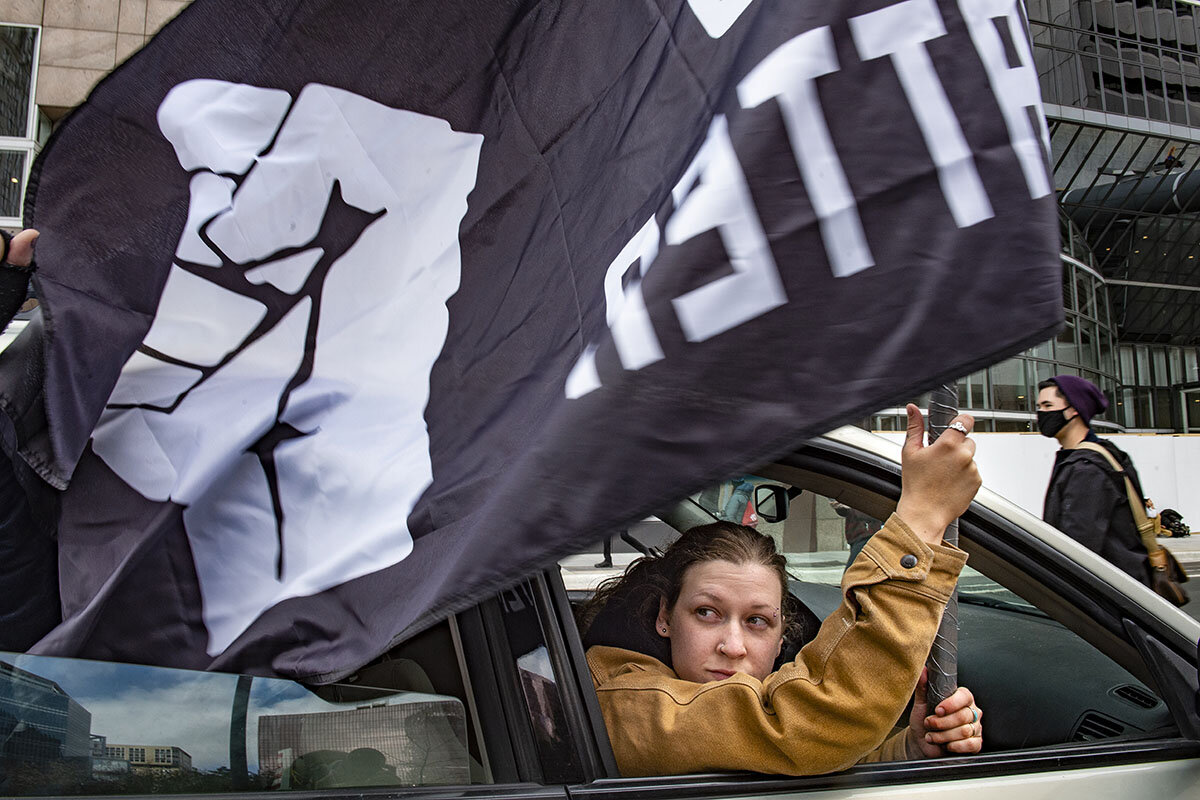
This commentary is going to be a challenge – for me, first and foremost. The challenge is to see George Floyd’s death and everything that follows it in a holistic fashion.
I didn’t watch the video of Derek Chauvin’s murderous act. I didn’t watch Mr. Floyd succumbing to the pressure of Mr. Chauvin’s knee on his neck for more than nine minutes.
I didn’t have to watch it. I’d seen it all before – and saw myself, a Black man, in those scenarios.
The visceral pain from that viral video turned into protests – not just in Minnesota or the United States, but all over the world. I marched alongside folks and even organized a protest in my hometown. And I watched firsthand as a day of anti-police sentiment in Columbia, South Carolina, received a militarized response from the city.
Again, the challenge is to see this moment – and moments – holistically. It’s not about me, but us. Our perpetual response to Mr. Floyd’s death is what makes this moment, and everything that comes afterward, so important.
When I heard that a verdict had been reached in Mr. Chauvin’s trial, I thought about that moment – this moment – in its entirety. I understood that we were still in a fight to honor the lives of Breonna Taylor, Rayshard Brooks, Sandra Bland, Daunte Wright, and too many others. I also knew what a guilty verdict would mean to a nation – a world – that watched with tired yet vigilant eyes.
The presence of justice
The guilty verdict for Mr. Chauvin was humanizing. That sentiment poured through the screen and my social media feeds when the verdict was announced – guilty on all three charges. People cried. People shouted. People fainted in the presence of justice.
What followed were promises and proclamations of redemption, and while I respect those claims, the ultimate feeling from Tuesday’s verdict for many was relief.
That relief wasn’t just from the residual pain felt for the names I mentioned earlier – and so many more. It was relief in the face of a judicial system that many people still feel isn’t just. The mere presence of justice was progress.
I’ve often thought about the humanity lost in these times – not just the loss of life, but the loss of living. The burden Black people face in the most common of situations with the police is not just the fear of losing one’s life, but the chance of being treated as less than human. While the restoration of humanity might start with a single verdict, it requires so much more than that decision.
True redemption begins when we prioritize and give power to the people as a whole. In this context, I am speaking about Black people, but I understand that people of various backgrounds and races have legitimate feelings about the overreaches of policing. Many of those conversations can start on a local level, where municipalities and cities appropriate significant portions of their tax dollars – more than 50% in some cases – to funding the police.
That is the great irony of the George Floyd Justice in Policing Act, which will undoubtedly receive a boost from the result of Tuesday’s verdict. As much as the legislation demands accountability related to racial bias in policing, police misconduct, and excessive force, it also pours a heaping helping of funding ($750 million, to be exact) into an already well-funded entity. And while it’s true that those additional funds would support independent prosecutions of officers using deadly force, that doesn’t get to the heart of the problem. True redemption would redistribute wealth toward efforts like health care and housing that help everyday people.
The promise of humanity
I am thinking about George Floyd, the man, now. I’m thinking about him independent of his actions the night he died and of Mr. Chauvin’s actions. I’m thinking about him moving to Minneapolis to get his life together, as Mr. Floyd’s friend and former NBA player Stephen Jackson told ABC News.
“He was excited to tell me he was driving trucks and he was going to Minnesota and start over – get a new start,” Mr. Jackson said.
It reminds me of the plans that Breonna Taylor and her fiancé, Kenneth Walker, had before tragedy struck.
Theirs are promises unrealized. But in this moment and the moments ahead, we have an opportunity to realize ours.
The promise of redemption must include more than the promise of police reform. It has to include the promise of opportunity for everyone. At the very least, it has to include the promise of humanity.
Ken Makin is the host of the “Makin’ A Difference” podcast.

Film
Oscar nominee ‘Quo Vadis, Aida?’ turns lens on legacy of Bosnian genocide
Can a movie keep history from repeating itself? Monitor film critic Peter Rainer says award contender “Quo Vadis, Aida?” succeeds in its mission to get people thinking and talking about the tragedy that occurred in Srebrenica in 1995.

-
By Peter Rainer Special correspondent
Oscar nominee ‘Quo Vadis, Aida?’ turns lens on legacy of Bosnian genocide
In July 1995, in the enclave of Srebrenica in eastern Bosnia-Herzegovina, over 8,000 Bosnian Muslims were slaughtered by the invading Serbian army in the largest civilian atrocity in Europe since World War II. Because the world then was mainly focused on the fighting in Sarajevo, this genocide did not receive the global outrage it demanded. “Quo Vadis, Aida?,” written and directed by Jasmila Žbanić, is an incendiary memorialization of that desperate time. It is also, by the end, an impassioned call for moving forward. Žbanić, who was living under siege in Sarajevo when the massacre occurred, is dramatizing this human catastrophe so that future generations will not repeat it.
Its main protagonist, Aida (Jasna Ðuričić), is a Srebrenican first grade teacher acting as a translator for United Nations officials who have established a supposedly “safe area” within the enclave. Thousands of civilians, with little access to food or water, have been packed into a fenced-off compound while thousands more outside clamor for entry. Among those outside are Aida’s husband, Nihad (Izudin Bajrović), and their two sons, 17-year-old Sejo (Dino Bajrović) and his older brother, Hamdija (Boris Ler).
As it becomes increasingly clear that the blue-helmeted Dutch U.N. peacekeepers are powerless to stop the Bosnian Serb forces from inciting a slaughter, Aida, amid the maelstrom, frantically tries to save her family. She proffers, as if it were a talisman, her U.N. pass allowing her safe passage through security checkpoints. She recognizes the doom that awaits her sons and husband if, like virtually all of the men, they are rounded up by the Serbian army.
Žbanić’s all-seeing eye for human detail is the main reason “Quo Vadis, Aida?” – a nominee, as of this writing, for the Oscar for international feature film – is much more than just a straightforward political thriller. When, for example, Aida is imploring the occupying soldiers for mercy, one of them recognizes her as his former grade school teacher and seems quite happy to see her.
And yet, nothing good comes of this moment. The soldier, like so many in this tragedy, is just following orders. In another scene, Aida, reunited with her husband inside the compound, rips up and then burns their family photos along with the incriminating journal of the war years he has been keeping. What once was precious is now ashes.
Žbanić mostly keeps the film’s focus on Aida, although the director crosscuts scenes involving the U.N. negotiators and the Serbian forces headed by the imperially self-assured Gen. Ratko Mladić (Boris Isakovic, in one of the truest portrayals of murderous megalomania I’ve ever seen). In its every inflection, Ðuričić’s face registers the horrible wages of this war. Aida knows she has no time to give in to despair. She looks both valiant and aghast.
Žbanić refrains from showing us the worst of the atrocities that actually occurred, and this is probably for the best. Near the end, in a single, motionless camera setup, we see the wives and widows attempting to identify the remains of their families, and the stark simplicity of the tableau is more resonant than any explicit violence could ever be.
Although Serbia has yet to officially call the Srebrenica massacre a genocide, even though it was so ruled in 2007 by the International Court of Justice, it’s clear that Žbanić looks to the children and grandchildren of that generation to fulfill a higher ideal. That’s why her last scene is of a grade school play in which children of mixed ethnicities, their faces framed in a series of beaming close-ups, fill the screen.
She is not naive. Žbanić knows that the perpetrators of the massacre were once children, too. But she has said in interviews that her purpose here is to invite people to come together. In its own fervent and sorrowful way, I think her film succeeds in that improbable mission.
Peter Rainer is the Monitor’s film critic. “Quo Vadis, Aida?” has English subtitles. It is available on streaming platforms including Amazon Prime Video, iTunes, and Hulu.
Other headline stories we’re watching
(Get live updates throughout the day.)The Monitor's View
From three tragedies, cathartic breakthroughs
- Quick Read
- Deep Read ( 3 Min. )
-
By the Monitor's Editorial Board
When a breakthrough is reached on an important public issue after a long period of resistance or inertia, there is a tendency to look to circumstance for an explanation of the change. When a shift touches on several intractable problems at once, it is worth asking if something deeper is happening.
In the space of just a few days, three significant hurdles were cleared. World leaders set aggressive new targets to cut carbon emissions. A police officer in the U.S. was convicted of murdering a Black man. And the Group of Seven nations, led by the United Kingdom, launched an international partnership to prevent future pandemics.
This does not mean that the pandemic, climate change, and the problems of race and American law enforcement have been solved. But the headlines this week point to a broadening acknowledgment, as the Rev. Dr. Otis Moss III of Chicago’s Trinity United Church of Christ said, that “we are all interconnected, inextricably bound to each other.”
Jolted by necessity, much of humanity is taking a fresh look at neglected problems – and this collective awakening by individuals has helped redefine the common good. Tragedy has led to shared purpose.
From three tragedies, cathartic breakthroughs
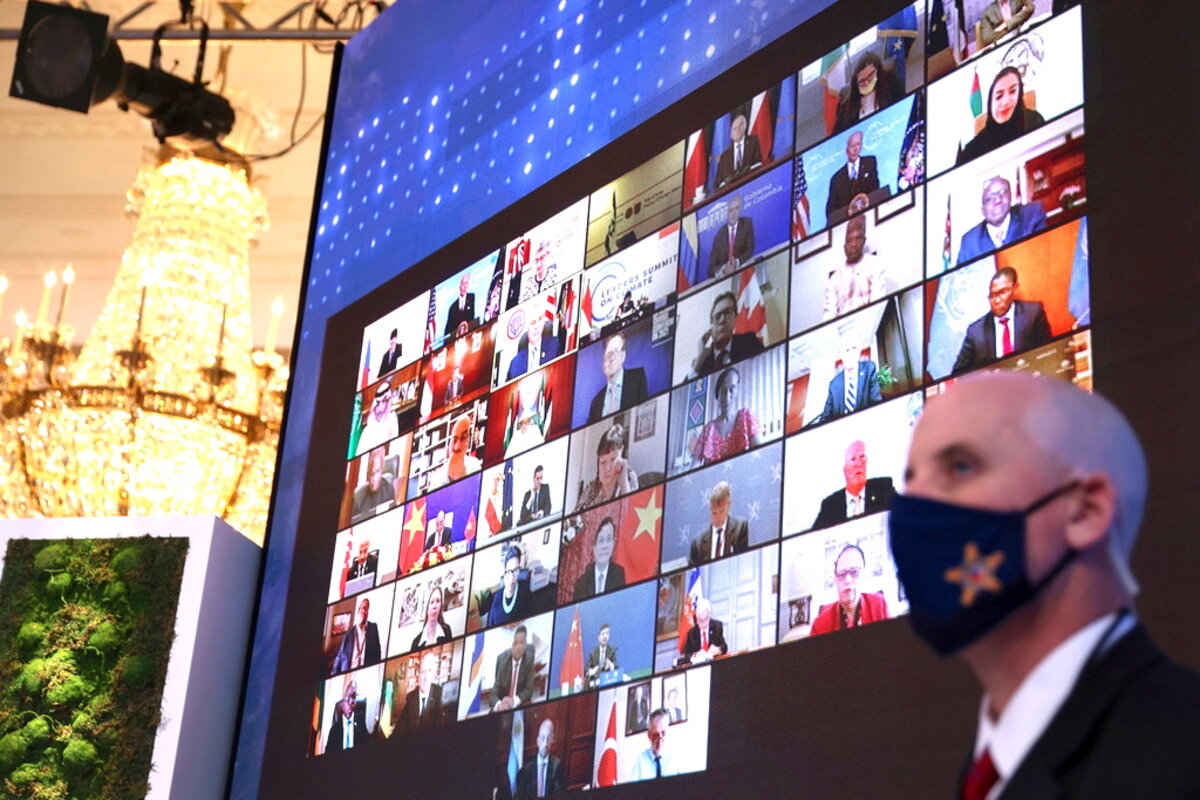
When a breakthrough is reached on an important public issue after a long period of resistance or inertia, there is a tendency to look to circumstance for an explanation of the change. A rare alignment of relevant factors, perhaps, or a novel deal between political rivals. When a shift touches on several intractable problems at once, it is worth asking if something deeper is happening.
In recent days, three significant hurdles were cleared. World leaders set aggressive new targets to cut carbon emissions. A police officer in the U.S. was convicted of murdering a Black man. And the Group of Seven nations, led by the UK, launched an international partnership to prevent future pandemics.
This does not mean that the current pandemic, climate change, and the problems of race and American law enforcement have been solved. Pledges on climate change have been made and missed for decades. An average of four Americans were killed by police each day during the 22-day trial of former Minneapolis officer Derek Chauvin. In India COVID-19 cases are spiking rapidly.
But the headlines this week point to a broadening acknowledgment, as the Rev. Dr. Otis Moss III of Chicago’s Trinity United Church of Christ said in The Washington Post, that “we are all interconnected, inextricably bound to each other.”
Among the reasons for this may be political shock and recognition of a common adversary. A year ago, as countries were scrambling to shut their streets and borders to contain the coronavirus, Columbia University psychology professor Peter Coleman noted that history often pivots when people are jarred by crisis into a wider range of urgency and empathy. Nazi Germany’s 56-day bombing campaign against Britain, he told Politico, stirred “an ascendance of human goodness – altruism, compassion, and generosity of spirit and action.” He foresaw a similar response in the pandemic, noting that “the time of change is clearly ripening.”
In a similar way, the shock of a nine-minute video led to the Chauvin verdict while erratic weather over the past year has led to heightened alertness to its causes. Recognition of these outsize events has shaped public coordination on solutions. At his virtual summit on climate change yesterday, President Joe Biden vowed to cut U.S. greenhouse gas emissions by at least half by 2030 from 2005 levels. Japan, Britain, and the European Union made similar pledges. Those goals invite skepticism. The goals will require massive and rapid transformations in power grids, infrastructure, transportation, agriculture, and construction.
Yet their boldness, like the response to COVID-19 or the injustice in Minneapolis, reflects a reaching toward a higher good. Mr. Biden cast the climate crisis as “a moral imperative.” The challenge of police brutality, argued the Rev. Dr. Roderic Land of Calvary Baptist Church in Salt Lake City, Utah, in the Deseret News yesterday, made clear that “somehow we have to start seeing each other as human beings and as brothers and sisters, period.” How, he asked, “do we begin to help police officers see that ... these people of color are also human?”
Jolted by necessity, much of humanity is taking a fresh look at neglected problems – and this collective awakening by individuals has helped redefine the common good. Tragedy has led to shared purpose.

A Christian Science Perspective
Each weekday, the Monitor includes one clearly labeled religious article offering spiritual insight on contemporary issues, including the news. The publication – in its various forms – is produced for anyone who cares about the progress of the human endeavor around the world and seeks news reported with compassion, intelligence, and an essentially constructive lens. For many, that caring has religious roots. For many, it does not. The Monitor has always embraced both audiences. The Monitor is owned by a church – The First Church of Christ, Scientist, in Boston – whose founder was concerned with both the state of the world and the quality of available news.
Embrace the childlike spirit within
- Quick Read
- Read or Listen ( 3 Min. )
-
By Kim Hedge
No matter where we are in life, nurturing qualities such as joy, purity, and innocence empowers us to experience God’s promise of peace and healing.
Embrace the childlike spirit within
In the Bible, Jesus speaks of how we must be like little children to enter the kingdom of heaven. “Jesus loved little children because of their freedom from wrong and their receptiveness of right,” explains Mary Baker Eddy, founder of The Christian Science Monitor (“Science and Health with Key to the Scriptures,” p. 236). When I think of little children, I think of qualities of freedom, joy, light, innocence, purity – wonderful qualities for people of all ages.
I’ve found that the more I learn about and embrace my relation to God, our divine Parent, the more naturally I express these childlike qualities and experience the promise of God’s kingdom here and now.
When I was in my 20s, I tried to be anything but childlike. Among other things, I certainly did not want to be told what to do by a parent – either human or divine!
But life quickly became complicated. I was a bit like the son in a story Jesus once told, who lived frivolously and did all kinds of stuff that wasn’t very childlike. Eventually, he lost everything and was filled with shame and guilt and humbly returned home. I never really lost everything in the sense of being destitute and reduced to longing to eat even what was being served to pigs, as this guy did. But I certainly felt as though I had lost my innocence, joy, and peace. Deep down I knew I was doing things I didn’t feel right about. So for all my effort to try to “escape” or feel more free and just have fun and be happy, I actually felt trapped.
Around that time, in a conversation with a friend, she said, “You know, you’re not very good at being bad, and you’re not bad at being good... so just be you.”
It took me a while to figure out who that “me” truly is, but eventually I came to see that the most authentic way to think of myself is as the child of God. As God’s child I reflect and express true innocence, purity, freedom, and joy, as does each and every one of us.
This spiritual identity never changes, no matter what the material picture looks like. We each have a direct, constant, and continuous relation to our divine Parent that never wavers and is ever intact. When we are truly receptive to this spiritual fact, as a little child is receptive to good, we find that we can trust our Father-Mother God to provide for our every need, including healing, guidance, and peace of mind.
That’s what I’ve found in my own experience, as I’ve more humbly and wholeheartedly embraced my innate childlikeness. Unhealthy, unproductive routines naturally dropped away – but my life isn’t boring at all! And when I listen for God’s direction, things are much less clouded or complicated than they once seemed.
Mrs. Eddy once said in a speech: “Beloved children, the world has need of you, – and more as children than as men and women: it needs your innocence, unselfishness, faithful affection, uncontaminated lives. You need also to watch, and pray that you preserve these virtues unstained, and lose them not through contact with the world. What grander ambition is there than to maintain in yourselves what Jesus loved, and to know that your example, more than words, makes morals for mankind!” (“Miscellaneous Writings 1883-1896,” p. 110).
Being free, joyful, and good is inherent in our nature as children of God. Sometimes these qualities may seem buried under the weight of the responsibilities and burdens of life, or covered by negative views we’ve held about ourselves or others. But they are there for each one of us to rediscover. As my little nephew so wisely put it when he was 4 or 5 years old: “I don’t think you’re really a grown-up. I’ve only ever heard of ‘God’s children,’ not ‘God’s adults.’”
As we embrace that childlike spirit within us, we also find a more tangible sense of the kingdom of heaven – God’s peace and harmony – within us. We feel more of our God-given joy. No matter what stage of life we’re at, we can choose each moment to shed the layers of material thinking and negativity and nurture the child within us, and find the promise of peace and fulfillment right where we are.

A message of love
Olympics takes step forward

A look ahead
Have a great weekend! On Monday, Dominique Soguel will be looking at how the pandemic has led to a brain gain for countries like Italy and Romania. Top talent returned home – at first to care for family, but now for good.



